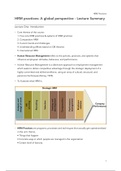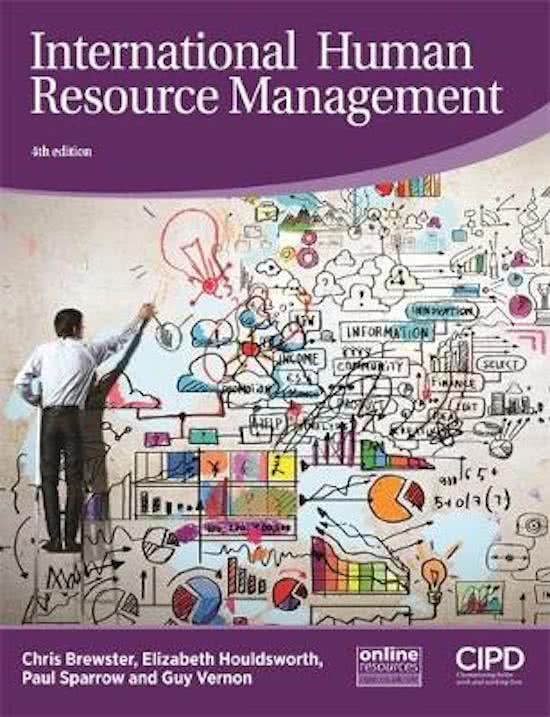HRM Practices
HRM practices: A global perspective - Lecture Summary
Lecture One: Introduction
- Core themes of the course:
1. Five core HRM practices & systems of HRM practices
2. Comparative HRM
3. Current trends and challenges
4. Understanding effects based on OB theories
5. International HRM
- Human Resource Management refers to the policies, practices, and systems that
influence employees' attitudes, behaviour, and performance.
- Human Resource Management is a distinctive approach to employment management
which seeks to obtain competitive advantage through the strategic deployment of a
highly committed and skilled workforce, using an array of cultural, structural, and
personnel techniques (Storey, 1995).
- To illustrate what HRM is:
- HRM Practices are programs, processes and techniques that actually get operationalised
in the unit. Hence,
• Things that happen
• Concrete ways in which people are managed in the organisation
• Certain level of facticity
!1
, HRM Practices
- In contrast, some argue that HRM practices are the actual, functioning, observable
activities, as experienced by employees. So,
• Actual practices and experiences
• Observable
- Fire core HRM practices:
1. Employee relations and collective communication
2. Recruitment and selection
3. Performance management
4. Rewards
5. Training and development
- Employee Relations concerns matters of overarching employment or collective
workforce policy, such as bargaining (the traditional focus on industrial relations), and
expressions of the collective voice of employees.
- Currents trends and challenges in HRM practices, specifically employee relations and
collective communication, include changing nature of work (tele-working) and e-HRM.
- The importance of employee relations and collective communication for employee
commitment and retention is explained by the Exchange Theory.
- One of the purposes of Recruitment is to determine present and future staffing needs in
conjunction with job analysis and human resource planning. Selection - a linked but
separate practice after recruitment - then involves the identification of the most suitable
person from a pool of applicants.
- Currents trends and challenges in HRM practices, specifically in recruitment and
selection, include the war for talent and the unemployment versus tight labour
markets.
- An example of a few recruitment practices include internal recruitment, recruitment
agencies, word of mouth, company website, and educational institutions.
- A few selection practices include interview panel, one to one interview, psychometric
tests, assessment centres, and graphology.
- Performance Management involves the formal conversations between line managers
and employees about priorities and their achievements. But also include the HR
designed process designed to align the workforce with the strategy.
- A currents trend and challenge in HRM practices, specifically in performance
management, includes HRM analytics.
!2
, HRM Practices
- Expectancy Theory has effects on the outcome of performance management.
- People are the largest single operating cost item of most businesses. Rewards are used
to motivate employees and/or engender their active commitment or engagement.
- Currents trends and challenges in HRM practices, with respect to rewards, include
bonuses, performance related pay, and pay differences.
- Motivation Theory and Efficiency Wage Theory have effects on the outcome of
rewards.
- Rewards in picture:
- Comparative HRM: In some countries, such as the US and Germany, Performance
Related Pay is highly utilised to motivate clerical and manual employees.
- Training refers to the planned and systematic modification of behaviour through learning
events, programs and instruction which enable individuals to achieve the levels of
knowledge, skill and competence to carry out their work effectively. Here, Development
is the growth or realisation of a person's ability and potential through he provision of
learning and educational experiences.
- Currents trends and challenges in HRM practices, specifically in training and
development, include talent management, employability, and learning organisation.
- The Psychological Contract Theory has effects on the outcome of training and
development.
!3
, HRM Practices
Lecture Two: HRM in Context
- HRM in context is about gaining insight in various theories, perspectives and models on
the relationship between HRM and (national) context. It involves three main approaches:
1. Cross-Cultural Management - HRM across cultures
2. International HRM - issues related to the management of human resources in MNCs
3. Comparative HRM - differences/similarities in HRM across countries
(Note: this course only focuses on international and comparative HRM)
- What is the relevance of international HRM and comparative HRM?
Business and management has globalised, there is a growing extensity, intensity and
velocity of global interactions associated with deepening impact, such that the effects of
distant events can be highly significant elsewhere. Therefore, management should be
international and outward-looking, where there is a requirement to compare and learn
from different nations and cultures. Also, MNCs need international management skills
and knowledge transfer to subsidiaries.
- Best Fit versus Best Practice
• Best Fit Perspective outlines the importance of fit between HRM practices and internal
and external context. The effect of HRM practices are dependent on, for instance, the fit
with organizational strategy.
• Best Practice Perspective believes of the existence of a set of HRM practices that
leads to superior organizational performance - related to so-called high performance
work systems (ideal combination of practices).
- Question → Is HRM moving towards a set of best practices as a result of increasing
globalisation and increasing knowledge on the effectiveness of HRM practices?
- Four perspectives on HRM:
1. Universalistic, or best practice, models: deliver enhanced organizational performance.
Organisations are perceived as a black box where the question posed is what bundles of
HRM practices can impact performance?
2. Contingent: add intervening variables between HRM practice/outcome, usually
strategy, organizational context, external environment, or organizational learning
capability.
3. Configurational: internal dynamics of HRM system/how different elements combined
synergistically in different patterns/bundles, representing different orientations.
4. Contextual: significance of context, not merely as contingent variable but as a
framework for HRM decision-making.
!4






